Don't miss your chance to invest in 'Fabiola'!
Visit our crowd-funding page for our new production, "Fabiola"!
- Home
- Movie Making Course
- Screenwriting
Task 4. Write The Skeleton
The next step to screenwriting is to write the skeleton of your story. This is much more crucial when your script is based on an original story or events from history. When you are lifting a story from a book, the book itself is pretty much your skeleton.
When lifting a script, skim through the table of contents and write down a list of the strictly necessary chapters.
Although some of the content is all right while you are sitting with your tea, cuddled up with your blankie, and reading the book, the scene that tells the entire history of the Gordon family is quite lengthy for a movie, and sometimes only adds confusion for the audience. We had to make this adjustment when we were making Outlaws of Ravenhurst.
There just isn’t enough time during the span of a movie to keep up as the viewer. Make your list of chapters and don’t look back.
Next, write a very rough idea of what your movie is going to look like. It doesn't have to be long; it doesn't have to be interesting. It can be as detailed or as bare bones as you want.
It could be an outline.
Read through it and make sure that all your important points are there. Make sure that it follows your mountain. Are you really passionate enough about the story to turn it into an interesting movie?
If you scrap it now, you haven't lost much time, sweat or interest.
Really think about it:
- Is this a film you are passionate about making?
- Is it a film that your audience is going to enjoy?
If you answered "no" to either of these questions, seriously consider going back to Phase 1 and brainstorm a new story.
Task 4 Checklist:
1. Make an outline for your script.
2. Decide if this is a project you are willing to move forward with before putting too much time and effort into writing a script. If you find that you are not too in love with it, go back to the drawing board in Phase 1.
Task 5. Flesh It Out With The Details
Once you are sure you want to keep going, move to your screenwriting software for some scripting. I use FinalDraft and highly recommend using it.
This software comes all ready to start rock'n!
It has memory of characters so that you don't have to type them in every time. Seems like a small thing, but it is a major time saver. Overall this is a great program if you really want to be serious about moviemaking. It saves time, frustration, and I am still finding features that make me love it more and more!
Recently I found a feature that has reports for characters, locations, and scenes in the "Tools" section. These reports have really helped with planning our shot list and planning shoot days!
Another really cool feature, they have a beat board and an outline in the top, so that you can drop beats representing different story elements and even stretch them to be about the length you are hoping the element will take to tell.
Keep Your Characters Distinct
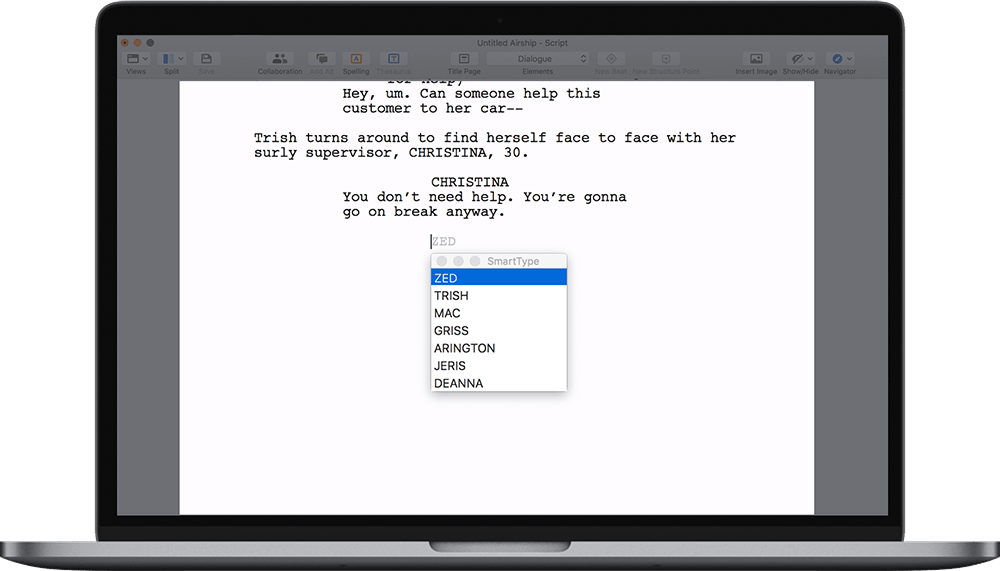
Begin to flesh out your story.
Although the earlier tasks probably only took you a few days or weeks each, plan on this task taking you at least two months. Don't feel discouraged if it takes you longer.
Great things take time to create.
Keep in mind that all your characters need to be distinct. Having an idea of who your actors will be is a tremendous help because you don't tend to make real people all the same. You will probably unconsciously draw in your actor's personality which is bound to be different from all the other actors.
An easy way to keep characters distinct is to find one flaw and one virtue that is going to be that character's virtue and flaw. If it is a main character, he usually conquers this flaw with the virtue.
This technique will keep you from blending all the characters into one person.
For example: In Aladdin, Aladdin's greatest flaw is the pretension he is playing. He loves Jasmine, but has to live the lie in order to marry her. He is willing to do anything to do that.
His greatest virtue is, in a way, honesty. In the end, he is willing to say that he messed up and walk away from all he had been working for. Even freeing the genie when he could have gotten it all back.
This honesty wins the Sultan's respect, Aladdin in turn wins what he wanted all along - the princess' hand. Win-win. The audience is happy and you have a winner!
Keep With The Mountain
Follow your outline and mountain to write the story. Think of movies you've seen for ideas on how to present dialogue. No character ever says, "Hey, my name is Michael. Here is my life story..."
Instead, the most important character's background is presented during the exposure period. It is not all told in the opening scene, sometimes it is the mystery the movie is based on.
In The King's Speech, for example, the audience spends the entire movie piecing together Bertie's childhood.
Another thing is, if the character's background is not important, don't include it. Most side characters don't give background and in most cases it is not needed.
Be careful with your climax, you want the audience to be at this part blankly pushing more popcorn in their mouths without leisure time to take their eyes off the screen. This is where they are totally arrested with the story and need the solution soon.
While screenwriting, don't go plummeting from your climax to the resolution. Remember you have a quarter of the movie to wind down. And don't forget to let your audience know that this is the wind down.
You can feel when a movie is nearing the end because everything is calming down a little and all the loose strings are coming to an artistic bow.
Give this sense to your audience by ending the climax and working slowly through the resolution. Don't sum up the movie in the last two minutes.
Task 5 Checklist:
1. Flesh out your skeleton focusing on the characters.
2. Work through your exposure, climax, and resolution. Get it all down first, then work through the whole script at least once before moving on to Task 6.
3. Focus on a strong climax, you will be focusing on the beginning and the ending in the next task.
Task 6. Format A Strong Beginning And Ending Using A Hot Balloon Analogy
Make Sure Your Beginning Sells The Movie
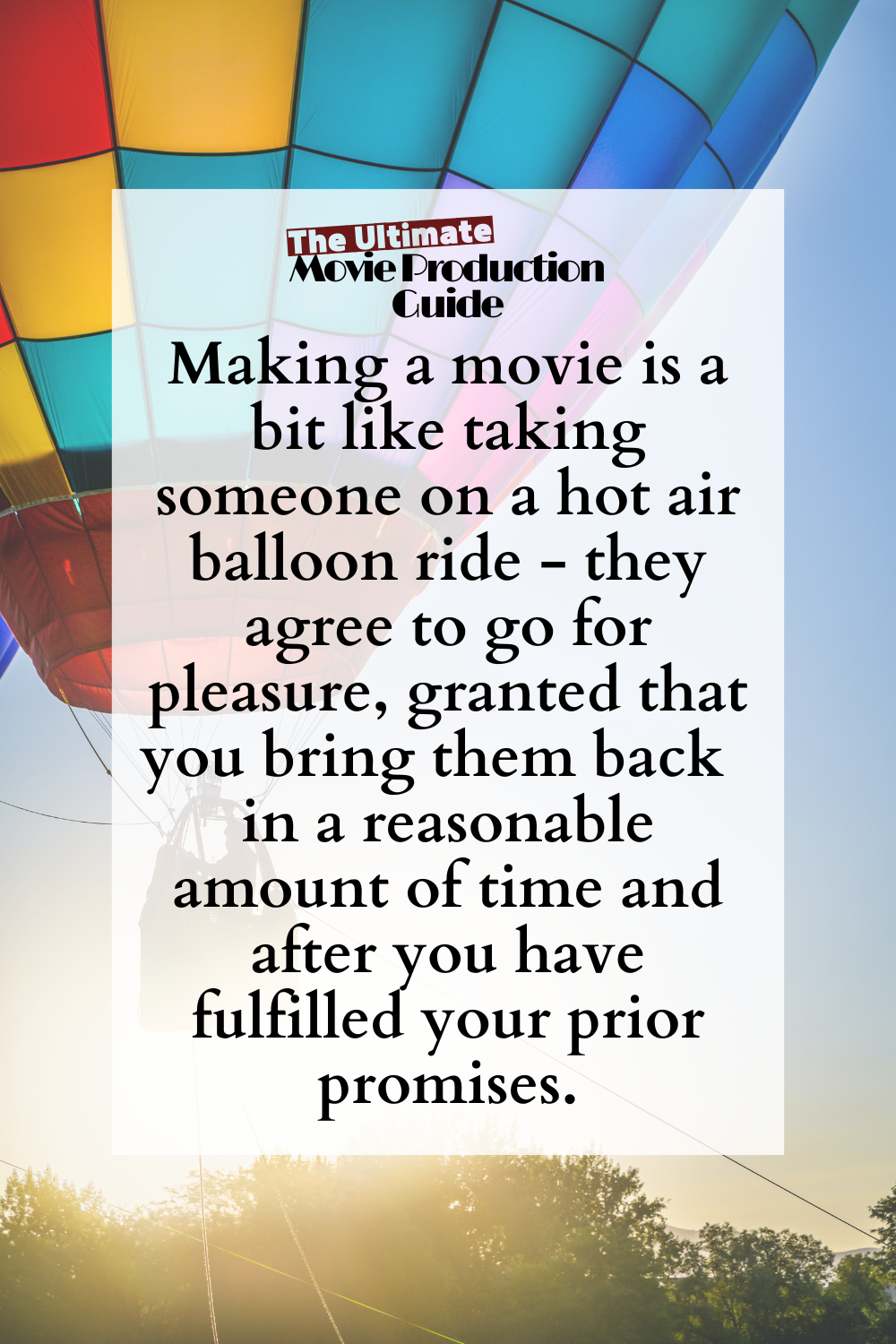
Your beginning is supposed to sell the movie. The last thing you want is for your audience to watch the first fifteen minutes, yawn and then wander into the kitchen to see if there are any scraps of food.
You want their attention captured so that thinking about a little snacky-snack is out of the question.
Making a movie is a bit like taking someone on a hot air balloon ride. (No, I've never done this, but you can still dream...)
They agree to go for pleasure, granted that you bring them back down to earth in a reasonable amount of time and after you have fulfilled any prior promises as to what they will see.
This is another part of the process when I highly recommend analyzing your favorite movies. How do they begin? There are basically three kinds of beginnings:
- The shocker or half story that leaves the audience in suspense (Outlaws of Ravenhurst, Hallmark's The Prince and the Pauper, The Hunt for Red October, Jurassic Park, Grisly Grisell)
- Telling a backstory (Emma, Tangled, Ella Enchanted, Gettysburg)
- The setup (Hook, National Treasure, Secondhand Lions, A Christmas Carol)
A shocker shows something visually exciting that stops abruptly, commonly followed by the opening credits. A murder, a sudden ambush, an execution, or a hair-breadth escape can often open the film.
It is regularly followed by a more calm opening that either follows the same character or drops him in suspense, showing a seemingly unrelated story that ties in during the climax.
A half-story is not usually visually exciting, just confusing. All the characters are excited about something: a death, a birth, whatever, but the audience is left confused as to what the exact cause is or whose death or birth is causing the excitement.
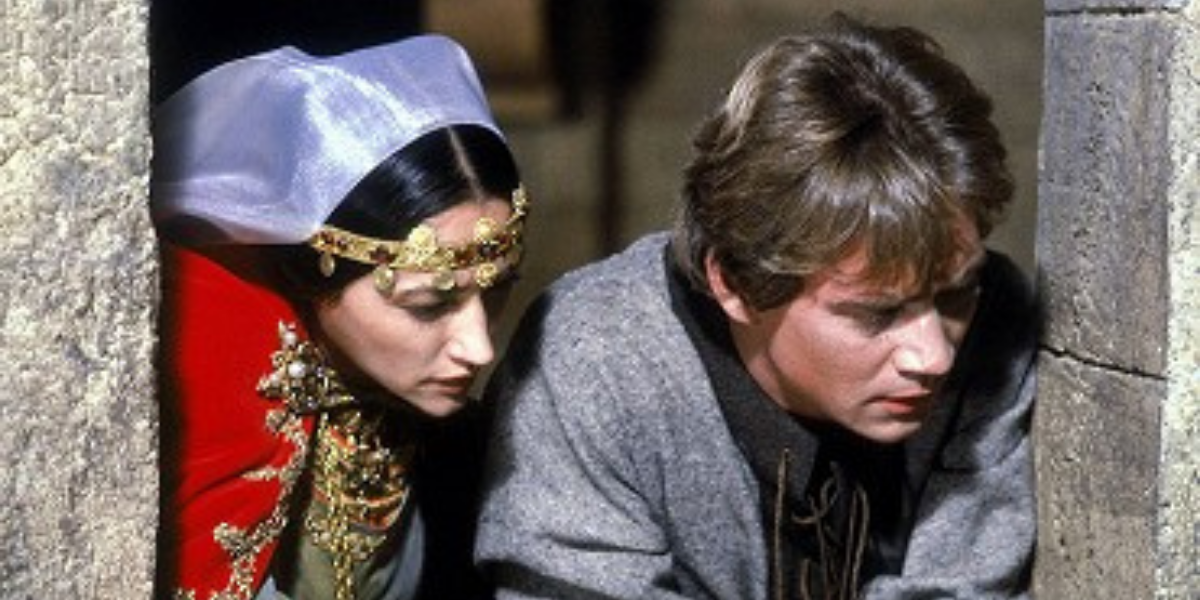
Movies that open with a backstory usually have a long involved history that would be very difficult to show or explain in the film.
One of the main characters or a narrator tells the story while visual aids are employed to accompany the backstory.
The rest of the film is told through the characters, with minimal narration.
The setup is similar to telling the backstory but is told through the characters. An initial conversation filling in details without feeling forced tells the audience the purpose of the story.
Genre greatly determines what kind of opening you are going to want to use. Thrillers, action and adventures, mysteries, and tragedies often have a shocker or half-story opening. Romances and tragedies typically open with backstories. Mysteries and comedies regularly have set-up beginnings.
Think about your genre and what kind of beginning that will be most fitting for your film. Be creative and have fun with your captivating introduction.
And They Lived Happily Ever After (Sometimes...)
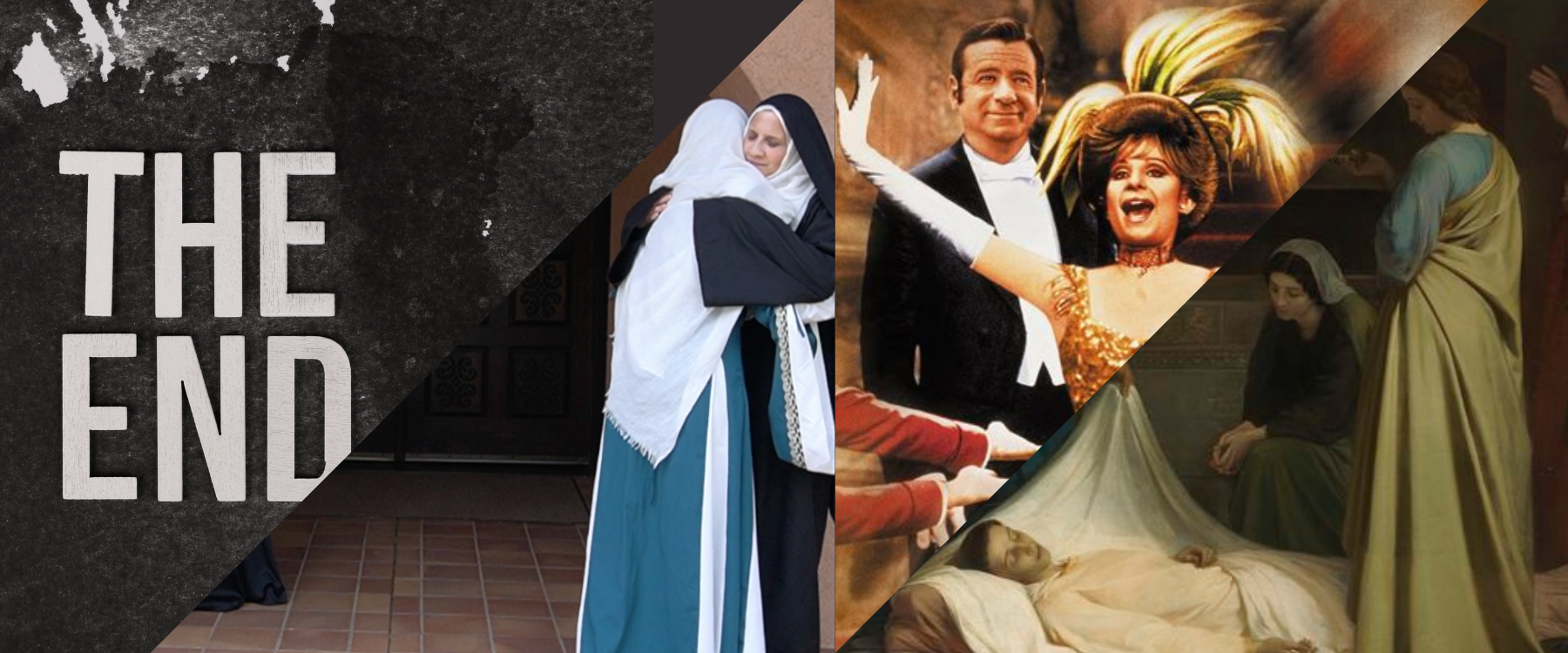
When you make a movie, you take your audience on a journey. This could be...
...exciting, romantic, tragic, fulfilling or even comical, but this adventure always ends by letting the audience go.
At the end, they can go back to life without feeling a sense of incompletion. This is an essential part of your movie: the ending.
Your movie can end in a variety of ways. There's the:
- "Aww! That was a cute movie!" (Hello Dolly)
- What Mary calls the "hole in your heart" ending (Max & Carlota)
- The inspiring ending (The War of the Vendee, The King's Speech), or
- New beginning (Tangled, Anastasia, Steel Magnolias, Journey 2: The Mysterious Island)
Whatever you do, choose one and stick with it. Don't try to combine them.
The cute movie ending endears the film to your audience. Typical of a romance, this kind of ending resolves all the problems and ends with a wedding or a celebration.
The hole in your heart ending inspires and saddens the audience. You must include an inspiring note to this kind of ending, otherwise your audience is just going to think, "Wow...that was really dumb." If you want tears, you also want a swelling feeling of inspiration.
The inspiring ending is an ending that leaves your audience feeling inspired. A death does not always have to be the event that inspires. Sometimes the most inspiring films are the ones about the main character overcoming the challenge (like in The King's Speech).
The new beginning ending completes the story and then gives just enough of a teaser about a future event to let you know what the characters are going to do next, but not too much to leave the audience feeling unsatisfied that they don't get to know how that event ends.
Pick your ending emotion and present it in the most creative and simple way possible. Although this may seem to be mostly the job of the actors and cinematographers, the screenwriting can do much to illicit the right feelings for the cast and crew to do their part to the fullest.
Once you have completed your beginning and ending, print the script out and review it. You will catch all the little mistakes on paper that you might miss on the computer.
Task 6 Checklist:
1. Create a strong beginning using one of the three typical movie beginnings (the shocker or half story, tell a backstory or use a setup).
2. Construct a good ending using one of the three emotions (cute movie, hole in the heart, or inspiring).
3. Review the entire script at least twice yourself.
Task 7. Find Three Trustworthy Project Consultants To Review The Script And Give You Constructive Criticism And Advice
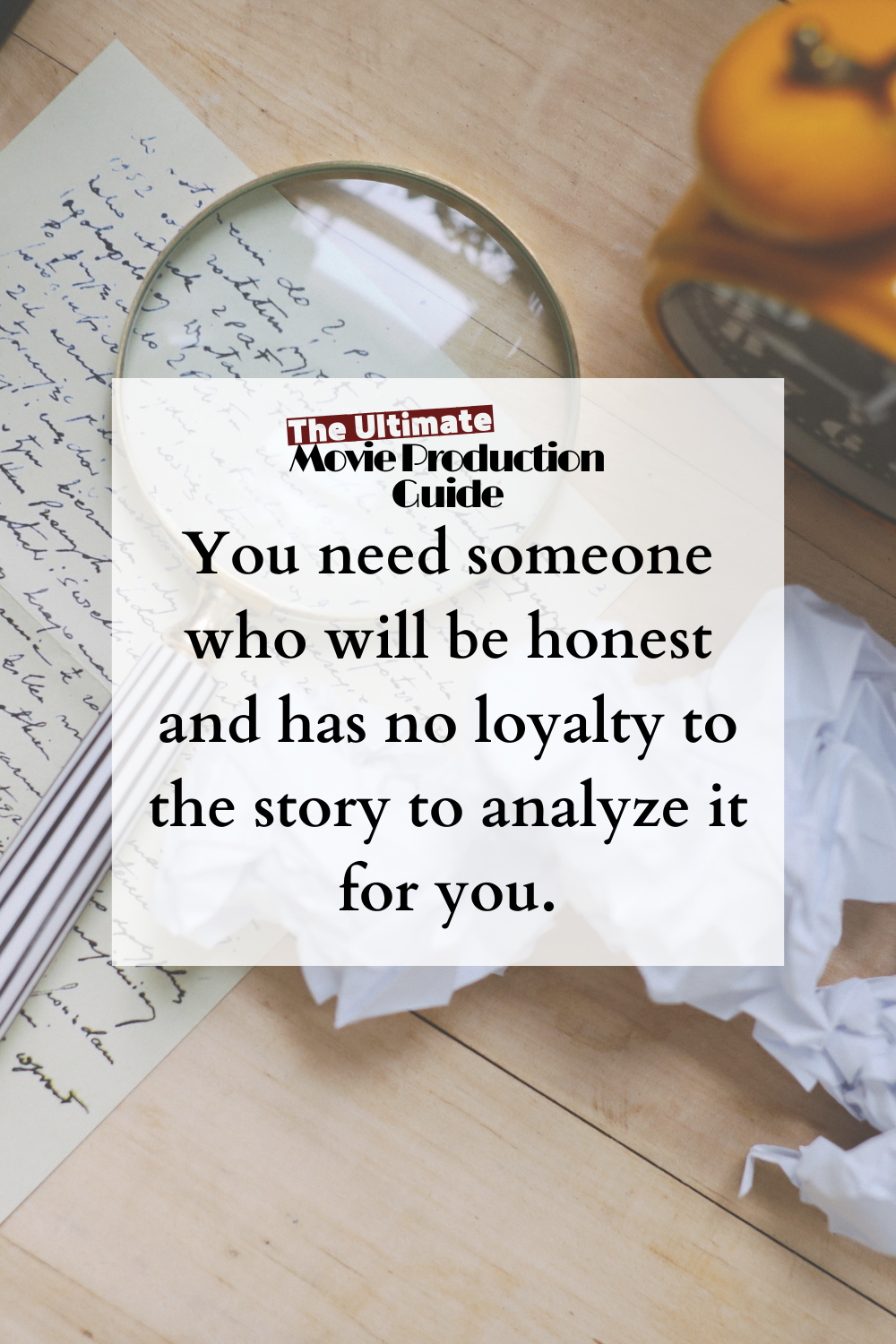
You don't need a whole bunch of consultants. Just three:
- one for grammar,
- a priest, and
- a detached friend.
For us, our producer is our grammar reader. She is very good at seeing the things that are written wrong as well as catching any story elements that need more or less explaining. Find someone you think would be good at this job for your project.
When I say "a detached friend," I mean someone detached from the story. This is a person who will tell you what things are unnecessary and what doesn't make sense.
After writing the screenplay and reading through it twice, you are really attached and everything is necessary and makes sense because you wrote it. That is why you need someone who will be honest and has no loyalty to the story to analyze it for you.
This is the truly pruning part of screenwriting:
Prune, prune, prune until it is perfect!
After you have made edits as suggested, choose a priest and send it to him to look over for any theological errors there might be.
This is a must do!
Even if the story is not particularly Catholic, you don’t want to make a movie that is theologically incorrect and even a slight danger to faith, especially the sensitive faith of young children. Although you are not intending it to be so, certain small things may escape your notice.
This may seem like it takes a lot of time, and it does, but you will end up with a strong story that is worth telling.
Using Grisly Grisell as an example, it took me about 15 hours total to write the first script, after having gotten it down to 80 pages on my own. Then I reviewed it with the director and producer.
We spent about 5 hours on it. Next I sent it out to a few consultants. Fixing their edits took me probably another hour. The director, producer and I looked it over one more time, really polishing it: another 2 hours.
So perfecting a one-hour film script takes about 23-25 hours from start to completion. For my pace, it's about 3 months worth of work.
Happy screenwriting!
With all this advice, you may feel more overwhelmed than ever, but don't get low. Screenwriting is fun once you get started. Dare I say...it's almost addicting. Once you get going, all you will want to do is work on it and get 'er done.
Happy screenwriting! Once you have completed this phase, you will be ready to move onto Phase 3, How To Create A Proposal.
Do You Still Have Questions About Screenwriting?
Did I miss something on this page? Do you have any more questions about your current screenplay, our current screenplay, screenwriting in general? Please leave it below. I'd be happy to help you with them!
